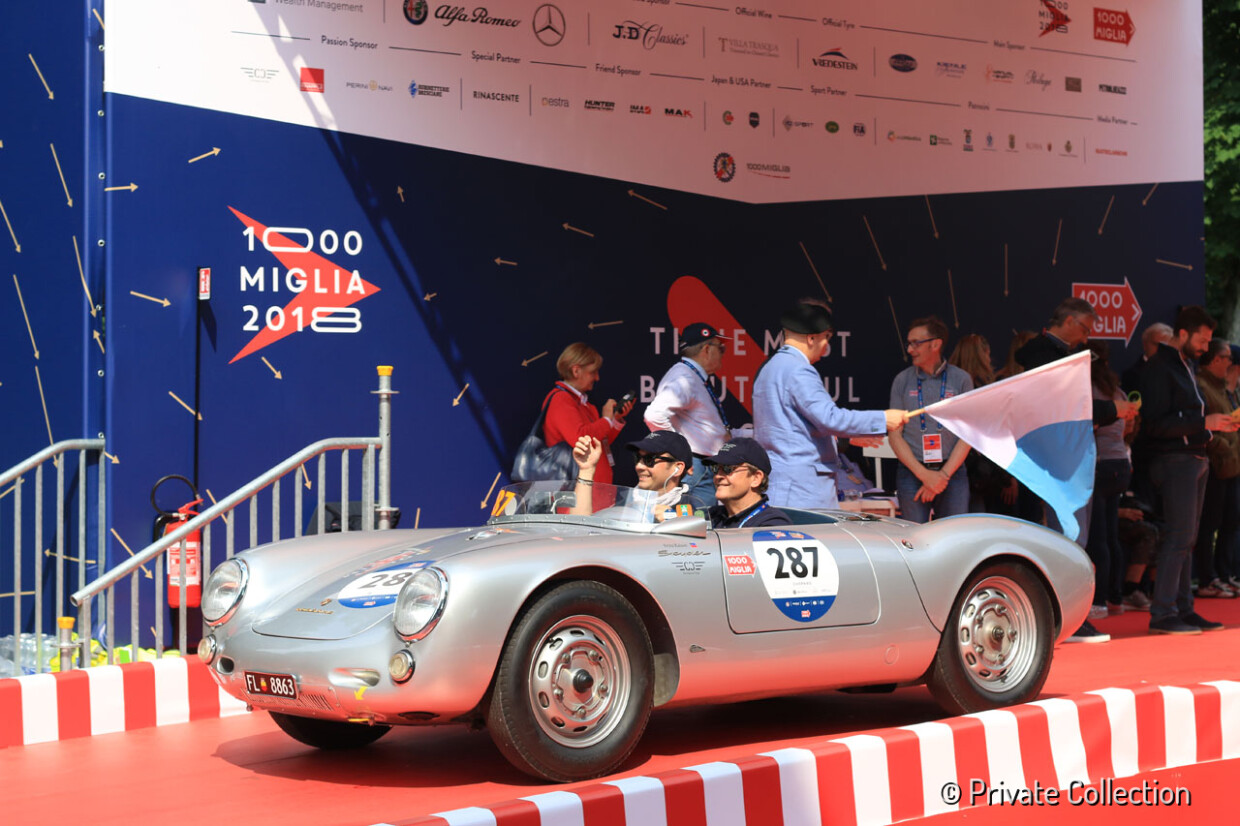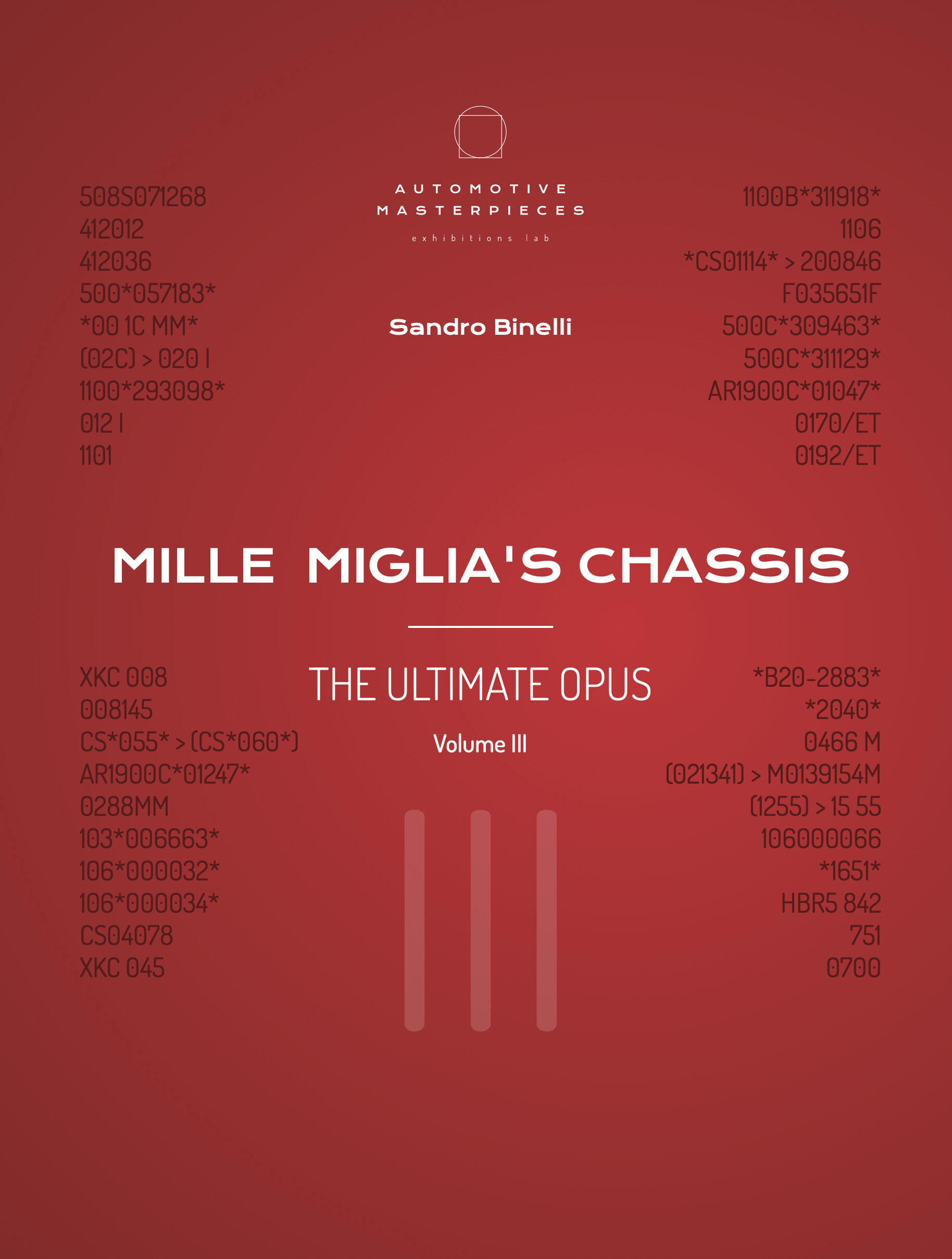
1956 Porsche Spyder Typ 550/1500 RS
ON/OFF
Why am I an Automotive Masterpiece?
J. Movie cars
16th January 1957 Checkpoint (UK) Checkpoint is a 1956 British movie. The genre can be defined as a noir, a crime or a drama, it was directed by Ralph Thomas and starring Anthony Steel, Odile Versois, Stanley Baker, and James Robertson Justice. The film was shot at Pinewood Studios in London with locations in Italy, including footage of the 1956 Mille Miglia. The 550-0084 appears in the race with the no. 432
L. Limited edition cars
no. 90 manufactured, 84th built. no. 90 manufactured, 84th built
Between the late 1940s and early 1950s, Porsche consolidated its first industrial and sporting activities with the production of the 356/2 “Gmünd”, assembled in the small Austrian facility in Carinthia. During that period, production was gradually transferred to Stuttgart, into a plant shared with Reutter coachworks, a technical partner since the earliest prototypes. However, the German brand needed a true racing success—something that could serve as a sounding board to boost sales. Moreover, up until 1952, the company still lacked an official emblem to present itself on international markets. A decisive impulse came from Max Hoffmann, a brilliant talent scout and importer who introduced the 356 to the American market, paving the way for Porsche’s first major commercial success overseas. Within this context of brand development, the Porsche crest was born: Franz Xaver Reimspiess, already credited with designing the Volkswagen logo in 1936, created an emblem featuring the rearing horse (symbol of the city of Stuttgart), framed by red and black stripes and stylized deer antlers derived from the coat of arms of Württemberg, now part of Baden-Württemberg. At the time, Porsche’s limited resources did not allow for a direct investment in factory-backed racing efforts. Thus, independent initiatives played a vital role. One of the most important came from Walter Glöcker, a former motorcycle racer and later a Volkswagen and Porsche dealer in Frankfurt. Together with engineer Hermann Ramelow, Glöcker developed several “special” cars using Porsche mechanicals. These cars, conceptually inspired by the original 356/001 barchetta, were built on custom tubular frames with mid-mounted Porsche engines and reworked rear suspensions. The first Glöcker-Porsche was completed in 1949, followed by a second, more refined version in 1950—some with engines downsized to 1,000 cc to comply with the sub-1100 class regulations. The bodywork was crafted by C.H. Weidenhausen of Frankfurt in a barchetta style with clear racing intent, visually reminiscent of early Porsche prototypes yet entirely original in execution. Glöcker’s car won the German championship in its class in 1950 and repeated the feat in 1951 (the same year Ferdinand Porsche passed away, on September 3rd) and again in 1952. These victories demonstrated the potential of a lightweight, purpose-built racing Porsche. Such results were instrumental in pushing the factory toward developing an official sports car, fully designed for competition. It was no longer sufficient to modify the 356 or rely solely on external support: the time had come to create Porsche’s first true racing model, directly inspired in spirit and construction by Glöcker’s barchettas.
The Porsche Spider type 550-1500RS, introduced at the 1953 Paris Auto Show, is one of the best-known icons of a racing car. Developed as a purpose-built machine, it was the result of an ideal fusion between the acclaimed Ferry Porsche's 356 and the racing prototypes built and driven by Walter Glöckler in the early 1950s. The internal project, numbered 550, began in 1952 on a tubular frame derived from the work of Hermann Ramelow, with wheelbase and tracks similar to those of the 356 and comparable suspension, wheels and brakes. The technical direction of the project was entrusted to Ernst Führmann, who designed the all-new Type 547 engine. This complex and compact 1.5-liter boxer-four was air-cooled and equipped with four overhead camshafts, actuated by bevel gearshafts rather than chains or belts. The architecture, reminiscent of the Cisitalia-Porsche designs of the late 1940s, was so sophisticated that its assembly required no fewer than 120 hours by a skilled technician. It became the foundation for all air-cooled Porsche engines through 1998. The first bench tests of the 547 engine in April 1953 yielded over 110 hp at nearly 6,500 rpm. However, as the unit was not ready for racing, the first 550 prototypes entered the Eifelrennen in May with the older 1500 Super engine. A promising class win led to Porsche's entry into the 1953 24 Hours of Le Mans, with two aerodynamic coupé-bodied 550s, which finished 15th and 16th overall and first and second in their class. From 1954 onwards, the 550 RS entered full-time competition, achieving major international victories: class wins at the Mille Miglia, Le Mans, Carrera Panamericana, and the 1000 km of Buenos Aires, among others. In 1955, Porsche prioritized customer teams, with cars still achieving outstanding results at Sebring, Le Mans (4th to 6th overall), the Tourist Trophy, and the Targa Florio. The model proved to be a consistent class winner, cementing Porsche's presence in endurance racing. Technically, the 550 featured the 1.5-liter Type 547 flat-four engine mounted behind the driver, paired with a transaxle gearbox. This mid-engine layout gave the 550 far better weight distribution than the 356. Brakes with finned drums on all four corners provided stopping power, typical of the era. The suspension design echoed contemporary Porsche systems but was paired with a new ladder-type tubular chassis—lightweight, rigid, and efficient. In 1956, the 550 A was introduced as an evolution of the model. It featured a new, lighter spaceframe chassis, updated rear suspension, improved aerodynamics and brakes, and a revised body built by Wendler Karosserie. Works cars weighed around 530 kg; customer cars about 570 kg. Engine development continued as well, with the Type 547/2 reaching up to 125 hp, and later evolutions exceeding 135 hp. The model became the base for the later 718 RSK. The 550 was notably low and light, with an excellent center of gravity and an outstanding power-to-weight ratio—the keys to its nickname: "giant killer." A well-known anecdote tells of German F1 driver Hans Herrmann driving a 550 under closed railroad gates during the 1954 Mille Miglia. Another notable aspect was that the car could be driven to the track, raced, and then driven home: a true dual-purpose machine. Though each Spyder was customized, there were often several in a race. Teams painted colored stripes or fins on the rear fenders to distinguish them in the pits, since most cars were painted silver—Germany's official racing color. Porsche was also the first manufacturer to adopt race sponsorship on its cars. While Reutter bodied the 356 road cars, the 550's bodywork was crafted by Wendler Karosserie of Reutlingen. Like many coachbuilders, Wendler had started as a carriage maker in the late 19th century and became known after WWII for its mastery of ponton-style bodies. The 550 represented the pinnacle of Wendler's contribution. The legend of the 550 also has a dark chapter: the car known as "Little Bastard," owned by actor James Dean. Dean purchased the car while wrapping up filming on Giant in September 1955. He was en route to the Salinas Road Race when he fatally crashed. From that moment, both the man and the car entered into myth. As for the car's name, a final anecdote tells that Ferry Porsche, grateful to Piero Dusio for having helped secure the release of Ferdinand Porsche and Anton Pïech after the war, chose to adopt the term "Spyder" in homage to Dusio's 1947 Cisitalia 202 Spyder Mille Miglia.
550-0084 is considered a piece of Austrian automobile history. With the owner and gentleman driver Gotfrid Köchert at the wheel, in 1956 it was a spectacular surprise at the Mille Miglia and won the Grand Prix of Germany at the Nürburgring. Köchert, the “racing jeweler” from the dynasty of the same name, a close friend of Jochen Rindt, was already 38 years old, when he ordered the car in Zuffenhausen. The archetypical gentleman driver, with the resources to afford the most expensive racing cars, he took the Mille Miglia seriously, private training the car for thousands of kms. Starting in Brescia with the 432 number, that is, at 4 o'clock 32 in the morning, reached Rome with a stunning race. His car was the fastest Porsche Spyder in the field, competing with world stars like Behra and Villoresi. But from Florence on, due to technical problems, he had to slow down and retire before Bologna. The same year, Köchert was 1st of class with this Spyder at the Nürburgring Grand Prix: the first great success of an Austrian driver, after the war.







